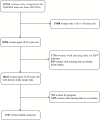Association between dietary folate intake and HPV infection: NHANES 2005-2016
- PMID: 38995887
- PMCID: PMC11244782
- DOI: 10.1371/journal.pone.0306636
Association between dietary folate intake and HPV infection: NHANES 2005-2016
Abstract
Background: Recent studies have established a correlation between folate levels and the incidence of cervical cancer. Given that Human Papillomavirus (HPV) infection is a primary etiological factor in the development of cervical cancer, the nature of the relationship between dietary folate intake and HPV infection remains an area of ongoing investigation.
Methods: To investigate the association between dietary folate intake and HPV infection, this study utilized data from the National Health and Nutrition Examination Survey (NHANES) spanning from 2005 to 2016. Multivariate logistic regression analysis was employed to examine the potential associations. Furthermore, the use of restricted cubic splines (RCS) facilitated the exploration of any non-linear correlations. Additionally, subgroup analyses were used to explore this correlation in different populations.
Results: The study encompassed a total of 6747 women aged between 18 and 59 years. For every one mcg increase in folate intake, the incidence of HPV infection is reduced by 1% (OR = 0.99, p<0.05). Besides, folate intake was categorized into quartiles as follows: Q1 (<211 mcg/day), Q2 (211-311 mcg/day), Q3 (311-448 mcg/day), and Q4 (>448 mcg/day). The adjusted odds ratios (OR) for the different folate levels were as follows: Q2: 0.94 (95% CI: 0.76-1.16), Q3: 0.84 (95% CI: 0.67-1.04), and Q4: 0.63 (95% CI: 0.49-0.81). The RCS analysis confirmed a nonlinear relationship between dietary folate intake and HPV infection risk. Notably, a significant inverse association was observed when dietary folate intake exceeded 193.847 mcg/day.
Conclusions: In conclusion, the findings of this study indicate a negative association between dietary folate intake and the risk of HPV infection. This association demonstrates a nonlinear pattern, particularly evident at higher levels of folate consumption.
Copyright: © 2024 Jin et al. This is an open access article distributed under the terms of the Creative Commons Attribution License, which permits unrestricted use, distribution, and reproduction in any medium, provided the original author and source are credited.
Conflict of interest statement
All authors declared that there have no conflict of interest.
Figures
Similar articles
-
Association between Dietary Vitamin E Intake and Human Papillomavirus Infection among US Adults: A Cross-Sectional Study from National Health and Nutrition Examination Survey.Nutrients. 2023 Sep 1;15(17):3825. doi: 10.3390/nu15173825. Nutrients. 2023. PMID: 37686857 Free PMC article.
-
Association between dietary folate intake and severe headache among adults in the USA: a cross-sectional survey.Br J Nutr. 2024 Feb 14;131(3):438-446. doi: 10.1017/S000711452300137X. Epub 2023 Jun 20. Br J Nutr. 2024. PMID: 37337781 Free PMC article.
-
Associations between nutrient intake and osteoarthritis based on NHANES 1999 to 2018 cross sectional study.Sci Rep. 2025 Feb 6;15(1):4445. doi: 10.1038/s41598-025-88847-y. Sci Rep. 2025. PMID: 39910214 Free PMC article.
-
Associations between folate intake, serum folate, and stroke risk: The mediating role of dietary inflammatory index from NHANES 2007-2018.J Stroke Cerebrovasc Dis. 2025 Jun;34(6):108318. doi: 10.1016/j.jstrokecerebrovasdis.2025.108318. Epub 2025 Apr 14. J Stroke Cerebrovasc Dis. 2025. PMID: 40239824
-
The association between serum folate and elderly diastolic hypertension: results from the NHANES (2007-2018).Blood Press. 2024 Dec;33(1):2380002. doi: 10.1080/08037051.2024.2380002. Epub 2024 Jul 17. Blood Press. 2024. PMID: 39018205
Cited by
-
Oral Treatment with EGCG, Folic Acid, Vitamin B12, and Hyaluronic Acid Improves HPV Clearance and Counteracts Its Persistence: A Clinical Study.Int J Mol Sci. 2025 May 29;26(11):5251. doi: 10.3390/ijms26115251. Int J Mol Sci. 2025. PMID: 40508059 Free PMC article.
-
L-type association between magnesium intake and human papillomavirus infection in US adult women: based on NHANES 2003-2016 data.Front Nutr. 2025 May 30;12:1594489. doi: 10.3389/fnut.2025.1594489. eCollection 2025. Front Nutr. 2025. PMID: 40521368 Free PMC article.
-
Composite dietary antioxidant index and HPV infection from single and mixed associations to SHAP-interpreted machine learning predictions.Front Nutr. 2025 Jul 31;12:1619742. doi: 10.3389/fnut.2025.1619742. eCollection 2025. Front Nutr. 2025. PMID: 40823022 Free PMC article.
References
MeSH terms
Substances
LinkOut - more resources
Full Text Sources
Medical



